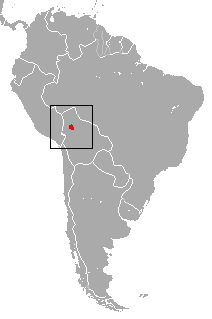Rio Beni titi monkey facts for kids
Quick facts for kids Rio Beni titi |
|
|---|---|
| Conservation status | |
| Scientific classification | |
| Genus: |
Plecturocebus
|
| Species: |
modestus
|
 |
|
| Rio Beni Titi range | |
| Synonyms | |
|
Callicebus modestus Lönnberg, 1939 |
|
The Rio Beni titi monkey (Plecturocebus modestus) is a small, tree-dwelling monkey. It is a type of titi monkey and belongs to the group called New World monkeys. This special monkey lives only in Bolivia, which means it is endemic to that country.
Contents
What is a Rio Beni Titi Monkey?
Rio Beni titi monkeys are known for their soft, thick fur. They are quite small, usually weighing less than two pounds. These monkeys have long tails, which are often longer than their bodies. Their tails are not used for gripping branches like some other monkeys. Instead, they help them balance as they move through the trees.
Appearance of the Rio Beni Titi
These titi monkeys have a reddish-brown or orange-brown body. Their undersides are often lighter in color. They have a distinctive black or dark brown forehead. Their faces can be quite expressive. They have large eyes that help them see well in their forest home.
Where Do They Live?
The Rio Beni titi monkey lives in the lowlands of northern Bolivia. Specifically, they are found near the Beni River. Their habitat is usually tropical rainforests. These forests have many tall trees and a lot of plant life. They prefer areas near water sources.
Life in the Trees
Rio Beni titi monkeys spend almost all their time in the trees. They are very agile and can leap between branches. They use their strong legs and long tails to navigate the forest canopy. They rarely come down to the ground. This keeps them safe from predators.
What Do They Eat?
These monkeys are mostly frugivores, meaning they love to eat fruit. They also eat leaves, flowers, and insects. Their diet changes with the seasons. When fruit is plentiful, they eat a lot of it. When fruit is scarce, they eat more leaves and insects.
Family Life and Social Groups
Rio Beni titi monkeys live in small family groups. These groups usually have a mother, a father, and their offspring. They are very social within their family. The parents often groom each other. They also sleep close together, sometimes with their tails intertwined. This is a sign of their strong bond.
Communication Among Titis
Titi monkeys are known for their unique calls. They make different sounds to communicate with each other. These calls can warn others about danger. They also use calls to mark their territory. Their calls are often heard in the early morning. This helps other titi groups know where they are.
Reproduction and Life Cycle
Titi monkeys typically have one baby at a time. The father plays a very important role in raising the young. He often carries the baby on his back. The mother usually only takes the baby for feeding. This shared parenting is quite special among monkeys.
Growing Up as a Titi
Baby titi monkeys are born small and helpless. They cling to their parents for safety and warmth. As they grow, they start to explore their surroundings. They learn how to find food and move through the trees. Young titi monkeys stay with their family group for several years. They learn important skills from their parents.
Conservation Status
The Rio Beni titi monkey is listed as an Endangered species. This means their numbers are decreasing. They face several threats in their natural habitat.
Threats to Their Survival
One of the biggest threats is deforestation. Their forest home is being cut down for farming and other human activities. This loss of habitat makes it hard for them to find food and shelter. Other threats include hunting and illegal pet trade. Protecting their forests is key to their survival.
See also


